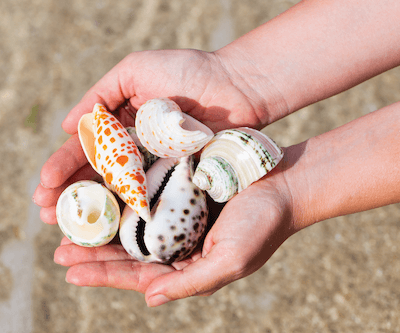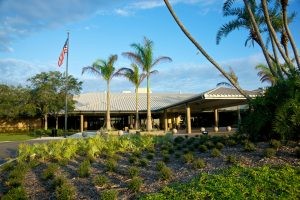Shelling with Care
Beachcombing Bliss
With over a dozen miles of pristine shoreline, Anna Maria Island and Longboat Key are the perfect destinations for shell seekers. Nestled along the calm Gulf of Mexico, these Bradenton Area barrier islands and neighboring keys provide a sanctuary for local wildlife and a wide variety of shell species. Collecting shells, or “shelling,” is a peaceful way to connect with nature while uncovering the treasures washed ashore by the gentle waves of the Gulf.

Anna Maria Island and Longboat Key are rich in marine biodiversity, offering a variety of shell species to discover. While strolling the shoreline, keep your eyes on the intertidal zone, the area of sand between high tide and low tide. Beachcombers can expect to find over 400 different species of shells here, including:
- Coquina Shells: These small, smooth shells often come in pastel shades of pink, yellow, blue, purple, and green. Sometimes you’ll find two halves still connected, resembling the outline of a butterfly.
- Scallop Shells: Also known as cockles, these shells are typically found lying flat on the sand, where their graceful ridges and fan-like shape are easy to spot. Scallops are the most common shell in Florida, and they come in various sizes, from quarter-sized to as large as your fist. Expect to find colors like cream, tan, purple, and yellow.
- Auger Shells: These slender, elongated shells look like drill bits and showcase intricate patterns in shades of brown, cream, pink, and white.
- Queen Conch Shells: An extremely rare find, these shells are vibrant pink and cream with a spiraling crown, making them stand out at the water’s edge.
- Sand Dollars: Although technically an urchin and not a seashell, sand dollars are prized for their beauty. They range in size from a half-dollar to a compact disc, with a star-like pattern and five distinct slit-like holes through their topside.

Shell-Seeking Strategies
Timing is key to shelling success. Locals know to venture out during low tide, when the Gulf waters retreat to reveal a diversity of shells waiting to be found. For even better results, hit the beach when low tide coincides with daybreak. This combination of natural events is when Mother Nature’s generosity truly shines, delivering a bounty of shells to clever collectors.
Sensible Shelling
While it might be tempting to gather as many shells as you can carry, it’s important to respect marine life and their delicate habitat. Live mollusks, sand dollars, and starfish play vital roles in the local ecosystem and should always be left undisturbed. Here’s how to tell if a “shell” is alive or occupied:
- Single-Shell Varieties: Look at the single opening to see if a snail or hermit crab still occupies the shell.
- Connected Halves: If the two halves are tightly sealed, it indicates someone is home.
- Live Sand Dollars: These appear purple-brown with a velvet-like feel, and their underside reveals thousands of tiny “feet” used for burrowing in the sand.
- Starfish: Look for slowly moving arms and hundreds of translucent tube-like feet lining the underside of their arms.
If you happen to pick up a live shell, sand dollar, or starfish, gently return it to where it was found. Our considerate actions today shape the Bradenton Area beaches of tomorrow.

Coastal Conservation
Carry a bucket or mesh bag to collect only a few prized shells, and take time to appreciate the natural beauty around you. By educating fellow beachgoers on responsible shelling and leaving living creatures undisturbed, you help conserve this delicate ecosystem. Embrace a leave-no-trace mentality, ensuring future beachcombers enjoy the same natural splendor that you experienced.

Get OUR NEWSLETTER
Get cool stories like this (and more local tips!) delivered right to your inbox when you sign up for our monthly e-newsletter.

Love it Like a Local
Join locals and fellow visitors alike in efforts to leave the area as beautiful as we found it so that future generations will be able to enjoy the same natural wonders as we are today.





